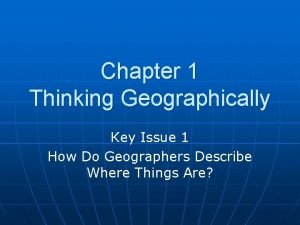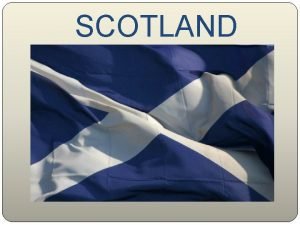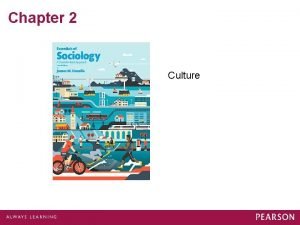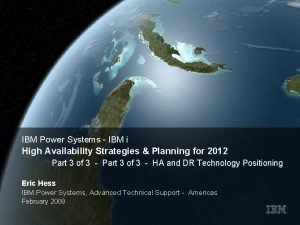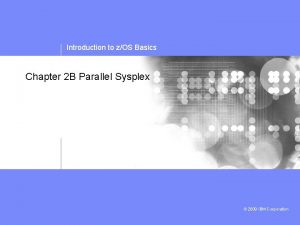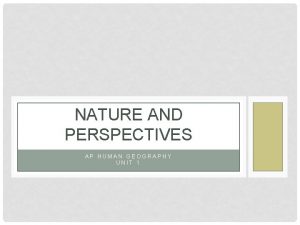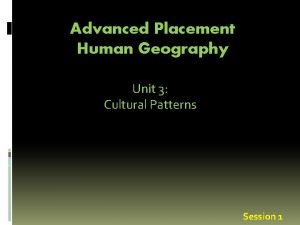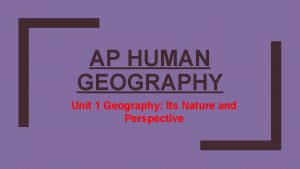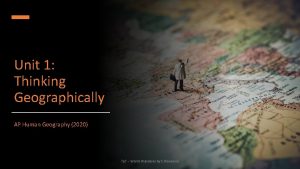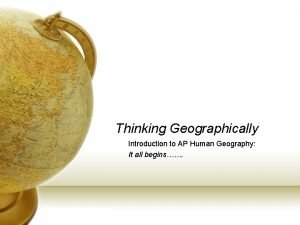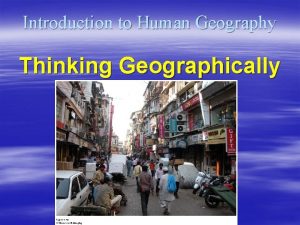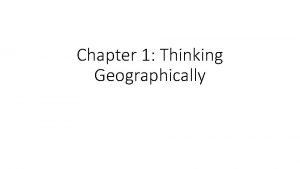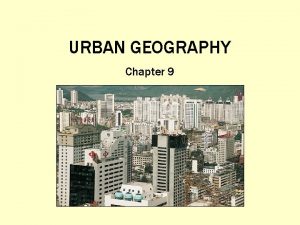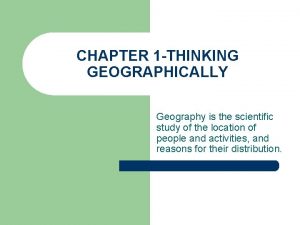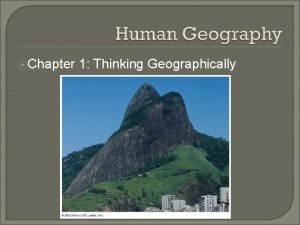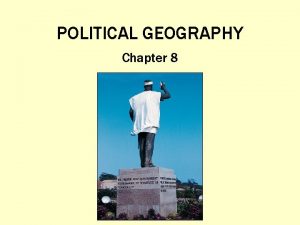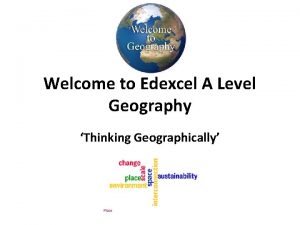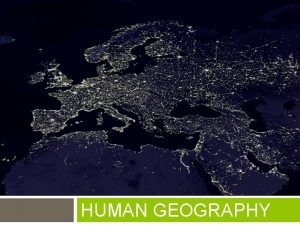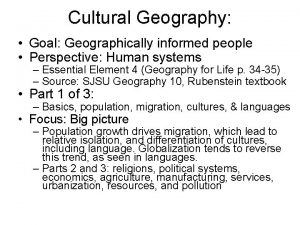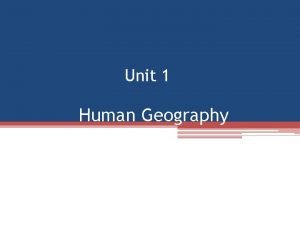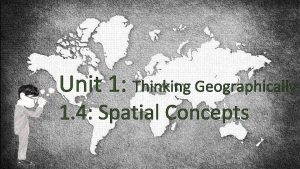Thinking Geographically UNIT 1 AP HUMAN GEOGRAPHY Do















- Slides: 15

Thinking Geographically UNIT 1 AP HUMAN GEOGRAPHY

Do Now: *Complete on a sheet of paper or in your Composition Book. Create a mental map of your ride from home to school or your neighborhood. Include any landmarks that always stand out to you. Include street names (if you know them)

Learning Objectives: Topics 1. 1 & 1. 2 1. 1: Introduction to Maps Identify types of maps, the types of information resented in maps, and different kinds of spatial patterns and relationships portrayed in maps. 1. 2: Geographic Data Identify different methods o geographic data collection.

Introduction to Maps

Introducing Geography Place: a specific point on Earth, distinguished by a particular characteristic. Region: area of Earth defined by one or more distinctive characteristics. Ex. The Eifel Tower is located in the city of Paris, France Ex. Florida is part of the Southeast region of the U. S. Scale: relationship between the portion of Earth being studied and Earth as a whole. Ex. Local scale and global scale

Cont. Space: the physical gap or interval between two objects. Ex. Houses that are close together and houses that are more spread out. Connection: relationships among people and objects across the barrier of space. Ex. Trains connect different cities to allow travel

Cartography: The Science of Mapmaking Maps can be used as reference tools (finding the shortest distance from one place to another) or communications tools (finding the distribution of human activities or physical features) Major Contributors to Geographic thought: Thales of Miletus (circa 624 – 546 B. C. ): applied geometry to measuring land area Anaximander (610 – ca. 546 B. C. ): made the first world map based on info from sailers. ; argued the world was a cylinder Pythagoras (ca. 570 – 546 B. C. ): may be the first person to propose the world was a sphere Hecateus (ca. 550 – 476 B. C. ): may have produced the first geography book called Ges Period Aristotle (384 – 322 B. C. ): the first to demonstrate the Earth was a sphere with evidence

Cont. Eratosthenes (ca. 276 – 195 B. C): inventor of the word geography; accepted the earth was round, calculated the circumference within. 5% accuracy, accurately divided eart into 5 climatic regions Strabo (ca. 63 B. C. – A. D. 24): described the known world in a 17 -volume work titled Geography Ptolemy (A. D. 100 – 170): wrote the 8 -volume Guide to Geography, prepared numerour maps that did not need improvements for more than 1, 000 years Muhammed al Idrisi (1100 – ca. 1368): prepared a world map and geography text in 1154 Abu Abdullah Muhammed Ibn-Battuta (1304 – ca. 1368): wrote Rihla which is based on 30 yrs of journeys spanning 75, 000 mi. through the middle east, N. Africa, Souther Europe, and Asia. Martin Waldseemuller (ca 1470 – 1521) German cartographer credited with creating the first map that used to label “America” Abraham Ortelius (1527 – 1598): created the firs tmodern atlas and hypothesized Pangea. Bernhardus. Varenius (1622 – 1650): produced Geographia Generalisi, which stood for more than a century as the standard treatise on systematic geography

Contemporary Geographic Tools Pinpointing Locations: GPS Global Positioning System (GPS): determine the precise position of something on Earth. GPS in the US uses 3 elements: Satellites placed in orbit around the Earth Tracking stations to monitor and control the satellites Receiver that locates at least 4 satellites to figure out the distance to each and uses the info to pinpoint its own location Analyzing Data: GIS Geographic Information Science (GIS): analysis of data about Earth acquired through satellite and other electronic information technologies. Captures, stories, queries, and displays the data.

Cont. GIS involves two types of data: Vector and Raster Vector Data consists of points and lines (ex. Cities and highways) and Raster consists of images, such as landforms. Collecting and Sharing Data: VGI Volunteered Geographic Information (VGI): the creation and spread of geo data contributed voluntarily by individuals; part of citizen science, which is scientific research by amateur scientists. Participatory GIS (PGIS): community-based mapping. Collect and spread local knowledge/info through electronic devices

Interpreting Maps: Map Scale: the relationship of a feature’s size on a map to its actual size on Earth. Ratio: ratio or fraction shows the numerical ratio between distances Written: describes relationship between map and Earth distances in words Ex. 1: 1, 000 miles = 1 unit represents 1, 000 miles on the Earth’s surface Ex. 1 centimeter represents 10 kilometers on earth Graphic: consists of a bar line marked to show distance on Earth’s surface Ex.

Projections Projection is the method of transferring the locations of Earth’s surface to a flat map

Types of Projections: Goode Homolosine: an equal area projection – largely preserve the size and shape of landmasses Distortions: Eastern and Western hemispheres are separated into 2 pieces (aka interruption), the vertical lines do not converge at all on the map

Cont. Robinson Projection: uninterrupted projection – useful for displaying info. Across the oceans Distortions: land areas are much smaller because of giving area to oceans

Cont. Mercator Projection: accurate shapes and directions Distortions: relative size is distorted toward the poles, making high-latitude places look larger than they actually are.
 Thinking geographically key issue 1
Thinking geographically key issue 1 Into what parts is scotland divided geographically
Into what parts is scotland divided geographically Where are the nacirema located geographically
Where are the nacirema located geographically Geographically concentrated buyers
Geographically concentrated buyers Ibm geographically dispersed resiliency for power systems
Ibm geographically dispersed resiliency for power systems Iseries high availability
Iseries high availability Geographically dispersed parallel sysplex
Geographically dispersed parallel sysplex Frq format ap human geography
Frq format ap human geography 5 themes of geography ap human geography
5 themes of geography ap human geography Ap human geography political geography test
Ap human geography political geography test Gni definition ap human geography
Gni definition ap human geography Unit 1 ap human geography
Unit 1 ap human geography Unit 3 ap human geography
Unit 3 ap human geography Gross national product definition ap human geography
Gross national product definition ap human geography Artifact example ap human geography
Artifact example ap human geography Disbursed ap human geography
Disbursed ap human geography
